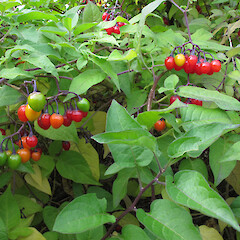Solanum dulcamara
Common name
bittersweet
Family
Solanaceae
Flora category
Vascular – Exotic
Structural class
Herbs - Dicotyledons other than Composites
NVS code
The National Vegetation Survey (NVS) Databank is a physical archive and electronic databank containing records of over 94,000 vegetation survey plots - including data from over 19,000 permanent plots. NVS maintains a standard set of species code abbreviations that correspond to standard scientific plant names from the Ngä Tipu o Aotearoa - New Zealand Plants database.
SOLDUL
Conservation status
Not applicable
Habitat
Terrestrial.
Wetland plant indicator status rating
Information derived from the revised national wetland plant list prepared to assist councils in delineating and monitoring wetlands (Clarkson et al., 2021 Manaaki Whenua – Landcare Research Contract Report LC3975 for Hawke’s Bay Regional Council). The national plant list categorises plants by the extent to which they are found in wetlands and not ‘drylands’. The indicator status ratings are OBL (obligate wetland), FACW (facultative wetland), FAC (facultative), FACU (facultative upland), and UPL (obligate upland). If you have suggestions for the Wetland Indicator Status Rating, please contact: [Enable JavaScript to view protected content]
FAC: Facultative
Commonly occurs as either a hydrophyte or non-hydrophyte (non-wetlands).
Detailed description
Unarmed, scrambling or sprawling perennial. Stems are usually hairless, with prominent raised lenticels; to 4 m long. Becoming woody towards the base. The leaves are ovate or broadly ovate, sometimes with up to 4 basal lobes or leaflets, which can be densely hairy, and a sharp leaf tip. Flowers are present as a flat or convex-topped inflorescence, or as loose panicles with 10-25 flowers present. The calyx is 2-3 mm long, divided nearly to the base with very shallow, hairy broadly triangular lobes. Flowers are purple, though sometimes white, and are narrow-triangular in shape, becoming recurved. Flowering occurs Nov-Mar. Characterised by bright scarlet shining almost ovoid berries, which contain seeds 2-3 mm diam.
Flowering
November, December, January, February, March
Flower colours
Violet/Purple, White
Year naturalised
1924
Origin
Eurasia, N Afr
Etymology
solanum: Derivation uncertain - possibly from the Latin word sol, meaning “sun,” referring to its status as a plant of the sun. Another possibility is that the root was solare, meaning “to soothe,” or solamen, meaning “a comfort,” which would refer to the soothing effects of the plant upon ingestion.
Reason For Introduction
Ornamental.
Poisonous plant:
The scarlet coloured berries of this plant are poisonous when eaten.









